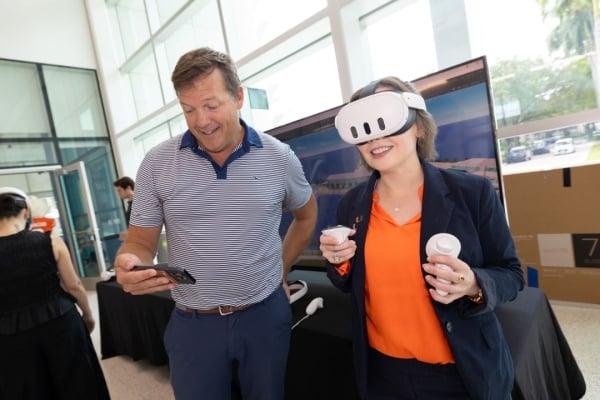As first-year students at the University of Miami, learners have the opportunity to run out of the tunnel with the football team, wander through the Lowe Art Museum, take a glassblowing class or paddle through the mangroves, all in the comfort of their own home.
The UMverse, a new virtual reality application built for incoming students, is the latest development out of the university’s XR Initiatives. The tech is integrated into a first-year seminar course assignment that encourages new students to explore campus, which university leaders hope boosts learners’ feelings of belonging and their comfort with using new technology.
The background: First Year Directions, the University of Miami’s first-year seminar, launched in 2019 to familiarize learners with support services, promote feelings of belonging and introduce students to the Coral Gables campus and southern Florida, among other goals, director of student retention Nicole Maarraoui says.
The class is taught primarily by staff members, and each section has around 20 students. In 2019, the university offered two sections of FYD; this fall, there are 85.
Throughout the term, students complete engagement reflection pieces on different areas of the college life, including social, personal and academic aspects and a Miami adventure project, Maarraoui says. But getting off campus to explore Miami has been a challenge, because very few first-year students own a car, and some are intimidated by public transportation.
In 2023, Thomas Merrick, senior project manager of XR initiatives and adjunct lecturer of interactive media, approached Maarraoui and her team to consider applications for virtual reality in the FYD class.
“We’re pushing the envelope trying to normalize the use of XR technologies, and we want to be leaders in that space,” Merrick says. That includes introducing younger learners to innovative tech.

Tom Merrick demonstrates the UMverse to a staff member. The software was developed by students, overseen by faculty members.
Over the past year, Maarraoui’s and Merrick’s teams collaborated to build the UMverse, equipped with 360-degree videos of unique experiences for student to learn more about campus and what makes Miami unique.
How it works: To enter the virtual world, students have three options: They can visit the XR Community Lab to check out a VR headset, take a headset home and try it there, or participate as a class led by an XR team member and their instructor.
Inside the UMverse, students can walk around, engage in different activities (like defending penalty shots on the soccer field) and watch 360-degree videos. The “digital twin” was built by students, overseen by faculty and software engineers, and inspired by feedback from staff. The virtual campus isn’t a perfect replica of Coral Gables, but it paints a similar picture.
All participants complete a consent form and a presurvey, which is used for assessment and research.
The university owns about 350 VR headsets—mostly Meta’s Quest models—with around 250 under the charge of the provost’s office and funds to purchase another 100, Merrick says.
The impact: Since launching this fall, 500 students (of the 1,700 in FYD courses) have submitted pre- and postsurveys. Through the surveys, staff hope to better understand students’ experiences using the VR and their perception of the university’s brand, among other sentiments.
So far, students have seemed to enjoy it. But Merrick has been surprised at the number of students who have never put on a headset before. Instructors, similarly, have been enthusiastic and excited to engage in the work.
“A lot of the questions [students ask] become, ‘Hey where else can we do that? Where else can I get that?’” Merrick says.
One factor Maarraoui and her team are cognizant of is balancing the accessibility of the tech and making sure students are still getting out of their dorms and visiting these places on campus in real life.
“Obviously, as first-year students, we want them to go out and explore what we have to offer. But I think something that we realized, which is, first-semester students, a lot of times they don’t know everything that’s out there. They don’t even know what’s so unique about our campus and about Miami, but also they might be a little bit nervous to [explore].”
The in-class experience can encourage students to engage more with the tech and with on-campus activities.
“It’s really just opening the doors for like, what it is that they could see themselves doing that, maybe before they had no idea [existed],” Maarraoui says. The VR component is also only one of four assignments students submit that require them to get out and try new things, she adds, so they’ll engage with the other three experiences in real life.
DIY: For an institution looking to model this work, Merrick cautions that the adaption and implementation will be a little slow.
“Have patience,” he says. “You are going to have to hand-hold a little as you move forward. But as it comes, your students will gain the skills and the recognition to feel a little bit more comfortable utilizing it.”
Maarraoui has also found value in integrating the VR demonstration into the class experience because it makes it easy for students to try it.
“Eventually we want students to be able to use these VR headsets at home or in their dorm or whatnot, but I think the barrier for some of them, especially first-year students, like, ‘Get out, go to the library, try it on your own,’ can be a little overwhelming,” Maarraoui says. “Finding a space or a classroom where you can bring it to them and pique their interests, I think it’s really important.”
How does your college or university integrate technology into the student experience? Tell us here.

